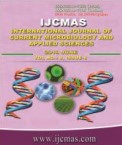


 National Academy of Agricultural Sciences (NAAS)
National Academy of Agricultural Sciences (NAAS)

|
PRINT ISSN : 2319-7692
Online ISSN : 2319-7706 Issues : 12 per year Publisher : Excellent Publishers Email : editorijcmas@gmail.com / submit@ijcmas.com Editor-in-chief: Dr.M.Prakash Index Copernicus ICV 2018: 95.39 NAAS RATING 2020: 5.38 |
Arbuscular Mycorrhizal Fungi (AMF) from the small phylum Glomeromycota forms symbiotic association with the roots of higher plants. The AMF appears to benefit by improving the uptake of phosphate and other nutrients from soil and also increases the disease tolerance to the host plant. Mycorrhizal plants produce certain substances that have been indicated as copartners in resistance to the attack of root pathogens. The GC-MS analysis of root and leaf samples of AMF inoculated plants of chilli infected with the damping off disease pathogen, Pythium aphanidermatum, a tripartite interaction (chilli-AMF-pathogen) indicated the presence of compounds such as carboxy-1-methyl-2-azetidione, 1,2-cyclobutanedicarboxylic acid, tetra hydrogeranyl-2-methyl butyrate, 1, 2-benzenedicarboxylic acid and benzaldehyde that are reported as potential defense factors by various authors. Fatty acids with antimicrobial properties are also detected in both leaf and root samples of AMF inoculated chilli plants infected by damping-off pathogen. Dibutyl phthalate is a bioactive compound that was present at high level in leaf samples of AMF treated plants. Shahamin-B, a diterpenoid with anti-feedant properties was detected in chilli leaves due to AMF treatment. The results clearly reveal that the defense factors were induced by the mycorrhizal plants at higher level compared to non-mycorrhizal plants that in turn hinder the establishment of the pathogen. This strategy occurring in crop plants due to AMF colonization in roots is documented to prevent the incidence of pathogen attack, thereby enhancing the growth and yield of crop plants.
 |
 |
 |
 |
 |